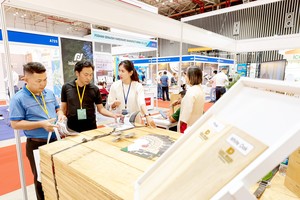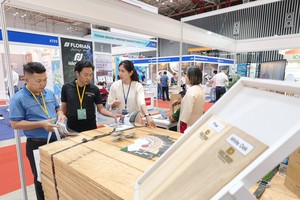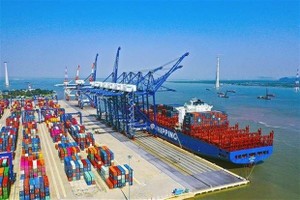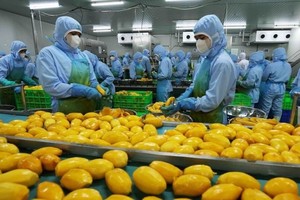
Most of the country’s largest wood producers locate in Binh Duong and Dong Nai provinces, contributing more than 50 percent to the country’s production and export value of wood products.
According to the Department of Industry and Trade of Binh Duong Province, there are around 1,215 wood producers in the province, of which there are 905 local firms with total registered capital of nearly VND10.84 trillion (US$467.38 million) and 310 foreign firms with total registered capital of $2.3 billion. There are above 250,000 laborers working in this field, of which seasonal unskilled workers accounts for around 40-45 percent.
Last year, export turnover of wood and forestry products hit $9.3 billion, making up more than 25 percent of total agricultural exports with trade surplus above $7.1 billion, of which, trade surplus of Binh Duong Province was $1.8 billion. In the first quarter of this year, wood processing industry was also the industry with highest trade surplus of the province.
According to Mr. Phan Van Binh, chairman of the Dong Nai Wood and Handicrafts Association (DOOWOHA), the provincial wood exports in the first months of this year grew more than 10 percent compared to the same period last year. It is forecast that the growth of export of wood products will be at 12-15 percent this year, in comparison with the previous year. Wood producers have received lots of orders and are speeding up to complete their contracts. Some wood producers even have signed contracts for the third quarter or the entire year. Last year, total wood exports of Dong Nai Province were nearly $1.4 billion.
With a long tradition in wood processing and skilled workers from the long-standing Bien Hoa craft village who have much experience in production development and management, Dong Nai’s wood producers are totally confident of fairly competing with foreign counterparts, especially, foreign-direct-investment wood producers in the province.
Mr. Dien Quang Hiep, chairman of the Binh Duong Furniture Association, said that the Comprehensive and Progressive Agreement for Trans-Pacific Partnership (CPTPP) which became effective as of December 30 last year has opened several big opportunities for the country’s wood processing industry. As import tariffs are cut to near zero percent at 11 member countries of the CPTPP, Vietnamese wood producers will have chances to expand market to countries, such as Japan, Canada, Mexico, Indonesia and Malaysia, and reduce their dependence on some countries including the US and European countries.
For instance, Vietnam is currently the second largest wood product exporter into Japan. According to the agreement, the effective CPTPP will lift 86 percent of total import tariffs of Japan. This will urge Vietnamese wood manufacturers to improve their products so as to increase margins.
As for Canadian market, CPTPP has brought opportunities for wood products, including floorboard and wood plank as an import tariff of 3.5 percent will be removed. Plywood, medium density fiberboard, picture frame, door frame and especially furniture will have the chance to enter Canadian market when import tariffs will be lowered to zero percent from 6-9.5 percent.
Although the door to global market is wide opened for Vietnamese wood producers, it is up to them whether they are able to take advantage of the opportunity or not. Years ago, wood producers in Binh Duong Province were small-sized firms with low investment capital and low productivity. Most of them used out-dated technology and their competitiveness and ability to approach customers were weak so not every firm was able to make use of the opportunity to participate in global market.
Currently, the most difficult problem for wood producers in Binh Duong and Dong Nai provinces is production capacity and personnel management. For example, a wood producer has a capacity to produce 100 products per day but when there is an order requiring it to double production or more, it is unable to accomplish the order though its productivity is at extremely low level.
Therefore, it is essential to focus on training workers to improve productivity as well as product quality before considering increasing production in order to maintain their prestige and long-term trade relations with their partners.
In addition, the source of raw materials, mainly rubber wood and Melaleuca wood, needs to be more plentiful and of higher quality so they can be used in processing products for export or exported as raw wood to countries which have demand for raw materials.
As for trade promotion, there are certain difficulties as the country does not have large trade centers to display wood products. The area of the largest trade center in Vietnam - Crescent Mall - is just 28,500 square meters while the area of trade center in Singapore is 120,000 square meters and that of trade center in Guangdong, China is more than 400,000 square meters.
























